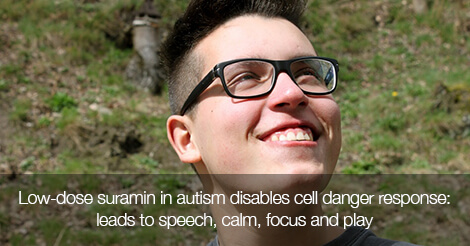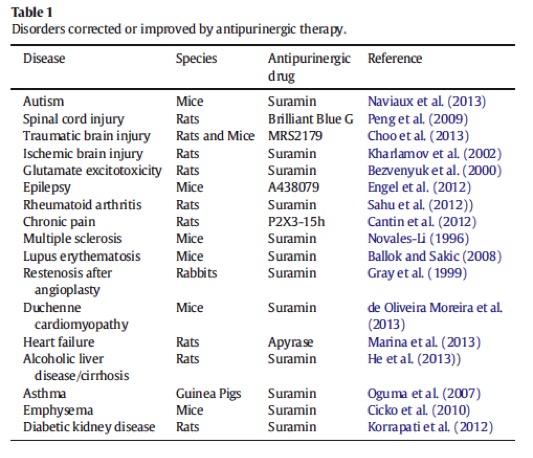
I’m fascinated and excited by this new research on cell danger response (CDR): Low-dose suramin in autism spectrum disorder: a small, phase I/II, randomized clinical trial abstract and the ramifications for autism as well as anxiety and other chronic health conditions. This recent study was double-blind, placebo-controlled and involved 10 boys, ages 5 to 14 years, all diagnosed with autism. Five of the 10 boys received a single, intravenous infusion of suramin and the other five boys received a placebo.
As reported in this Science Daily summary: Century-old drug as potential new approach to autism, the results seen in two of the autistic children after a single low dose of the 100 year old medication was profound:
The six-year-old and the 14-year-old who received suramin said the first sentences of their lives about one week after the single suramin infusion.
The most changed behaviors in all of the five boys who received the suramin were:
social communication and play, speech and language, calm and focus, repetitive behaviors and coping skills.
One of the parents of a 14 year-old who had not spoken a complete sentence in 12 years said this:
We saw improvements in our son after suramin that we have never seen before.
Within an hour after the infusion, he started to make more eye contact with the doctor and nurses in the room. There was a new calmness at times, but also more emotion at other times. He started to show an interest in playing hide-and-seek with his 16-year-old brother. He started practicing making new sounds around the house. He started seeking out his dad more.
We have tried every new treatment out there for over 10 years. Nothing has come close to all the changes in language and social interaction and new interests that we saw after suramin. We saw our son advance almost three years in development in just six weeks.
I can’t even begin to imagine the joy these parents must have felt to see their children respond like this!
Unfortunately the therapeutic benefits of suramin was temporary and the benefits gradually faded after several weeks as the effects of the drug wore off.
Suramin is used for African sleeping sickness and river blindness, which are caused by parasites and does have some very serious side-effects when used at higher doses (in AIDS research in 1987 sixteen patients died while receiving suramin or within three weeks of discontinuation of drug therapy).
In this autism study the children received a single very low dose intravenous infusion which did cause a rash.
The authors do acknowledge that suramin isn’t the solution but rather a way to test the cell danger hypothesis as a “possible unifying theory” that contributes to the cause of autism (and other chronic conditions that don’t resolve).
So what does the cell danger response actually mean? It’s taken me a fair bit of reading to understand it so let me share this explanation from one of the earlier mouse studies done by lead researcher Robert K. Naviaux, MD, PhD:
When cells are exposed to danger in the form of a virus, infection, toxin, or even certain genetic mutations [or traumas], they react defensively, shutting down ordinary activities and erecting barriers against the [real or] perceived threat. One consequence is that communication between cells is reduced which …may interfere with brain development and function, leading to autism [and other chronic conditions]
Even when the danger is no longer there – the infection or toxin or trauma has been removed, the diet has been changed, the nutritional imbalances have been addressed, the inflammation has been reduced etc. – the cells stay in danger mode and are not able to communicate and do what they need to do.
By using suramin the cell danger response/CDR signal is blocked or disabled or switched off so the cells no longer see the perceived danger, allowing cells to restore normal communication and function, and symptoms are reversed.
A simple way to think of it is like this: like a bear, the cells are in hibernation because it’s winter and when summer comes around they stay in hibernation because they still think there is the danger of winter or the lack of food. This is the cell danger response and the cells are stuck. The suramin tells the cells it really is summer, there is plenty of salmon and berries and it’s safe to come out of hibernation.
This approach is called antipurinergic therapy or APT and research shows it has applications for a number of conditions. These are disorders corrected or improved by antipurinergic therapy:

I’m excited about the amazing results in these children and about the promise of what this holds. But I do still have so many questions about this research and look forward to learning more and sharing more with you as I do:
- Why was suramin used and is there a safe drug that could achieve the same results?
- Or rather, what natural herb and/or nutrient/s can achieve the same or similar results without the side-effects?
- What is planned for future CDR research for children with autism and for other conditions? (I do know Dr. Naviaux is planning CFS research later this year)
- What role does vitamin B6 and serotonin play in all this? (the cell danger response yields vitamin B6 deficiency)
- Could there be applications for anxiety for you if you have tried ALL the nutritional/biochemical approaches and are still not seeing symptom resolution?
- Could this mechanism help you if you’ve been harmed by benzodiazepines, SSRIs and/or fluoroquinolones and can’t take any supplements?
- Could this mechanism help when you have a combination of many stresses like past trauma, genetic defects, heavy metals, mold and Lyme, as well as gut issues and nutritional imbalances?
Feel free to share insights and questions in the comment box below.